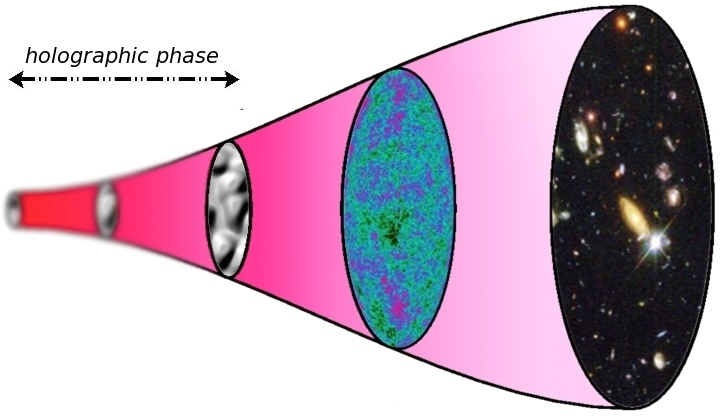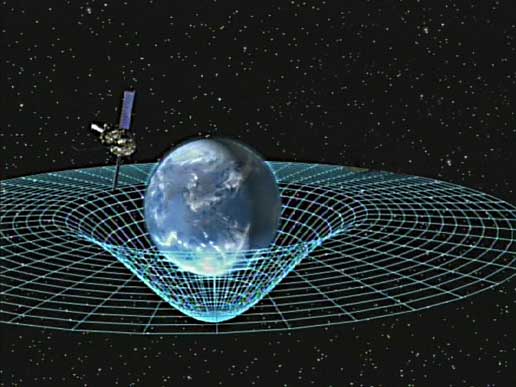By Doug Marman

A sketch of the timeline of the holographic Universe. Time runs from left to right. The far left is blurry because space and time are not yet well defined. Patterns from those early formative times shaped the development of stars and galaxies in the Universe today (far right). Credit: Paul McFadden.
Scientists from the UK, Canada, and Italy, recently announced the first empirical evidence that our universe is “holographic.” Unfortunately, the meaning of this is often confused. Even the scientists who published the report seem to be getting it wrong.
For example, one of the authors of the study, Kostas Skenderis, explained it this way:
“Imagine that everything you see, feel, and hear in three dimensions (and your perception of time) in fact emanates from a flat two-dimensional field. The idea is similar to that of ordinary holograms, where a three-dimensional image is encoded in a two-dimensional surface, such as in the hologram on a credit card. However, this time, the entire Universe is encoded.”
This explanation is backwards. Our perceptions and experiences don’t emanate from two dimensions. It is the objective space-time world that is a projection, a 2-D projection that leaves out the countless invisible exchanges that make it real.
This needs explaining, but the right picture is simple: Everything visible and tangible is only the surface appearance of invisible relationships at the quantum level. Objective reality is a projection on a two-dimensional surface.
This makes a whole lot more sense because we experience the same thing in our daily lives. All the important events of our lives are the results of relationships with others. Our attractions, desires, hopes and dreams all spring from these relationships and shape the outcome of the choices we make.
We aren’t surprised when two friends get married because we know their relationship is the cause. Marriage is the end result. The same is true for companies, institutions, and societies. Everything objectively visible is the outcome of invisible relationships. This is the lesson of quantum physics. (More on this in a moment.)
This raises a question: Why would scientists working directly with quantum equations get this backwards? There are two main reasons for this. First, because physicists have no agreed-on way to interpret quantum equations. Physicists don’t have a good explanation for what quantum relationships, such as entanglement, mean or why they exist. The result of this is that most scientists revert to an objective picture of reality, even though quantum physics suggests that there is much more going on beneath the surface.
The second reason is that mathematics has a peculiar limitation: It can’t distinguish cause from effect. It only shows us correlations. This makes it easy to get the story backwards. For example, look at Isaac Newton’s second law of motion, which says:
F (force) = m (mass) X a (acceleration).
It is easy to think this formula is telling us that forces make objects accelerate, but this is wrong. It only says that there is a relationship between force, mass, and acceleration.
Quantum experiments, on the other hand, have shown that forces are not true causes; they are the results of invisible quantum exchanges between charged particles.[1] Attraction and repulsion emerge from a quantum relationship that is not objectively visible.[2] This is where forces come from.
Or, to put this another way, forces are projections from a dimension that is not objective.
Space-time includes everything that is objectively visible, tangible, and measurable. In other words, this is the empirical world, the reality we see, hear, and feel with our senses. It turns out that this reality is a 2-D fabric woven from discrete events where energy is exchanged.[3]
This doesn’t mean the objective world is an illusion, but that it is only the surface appearance. It doesn’t capture the depths of our experiences any more than a person’s words, alone, capture the full meaning of what is hidden between their words, tones of voice, facial expressions and other non-verbal cues. The full meaning of what someone is saying is three-dimensional compared to their words alone.
However, even though many physicists picture the holographic principle backwards, they are right about the importance of this principle: It offers a bridge between the quantum world and the space-time universe. Over 10,000 papers have been written on the idea, because everything we have learned about quantum physics suggests that space-time emerges somehow from quantum entanglement. Now, we have the first empirical evidence that this principle is true.
The Lenses of Perception (LoP) Interpretation of Quantum Mechanics shows how space-time emerges from entangled relationships between particles, similar to the quantum theory of “decoherence.”[4] It also shows that space-time is two-dimensional because every particle is tied to space through other particles that it is directly in contact with, as other physicists have conjectured.[5] And it shows how invisible quantum exchanges cross over to become visible and objective, as other physicists have explained.[6]
This recent discovery adds further validation to the LoP Interpretation.
[1] Bruce A. Schumm, Deep Down Things: The Breathtaking Beauty of Particle Physics (Baltimore: John Hopkins University Press, 2004), p. 222-251.
[2] Ruth E. Kastner, Understanding Our Unseen Reality: Solving Quantum Riddles, (London: Imperial College Press, 2015), ch. 4, “Forces and the Relativistic Realm,” subsection: “Forces as Possibility.”
[3] Ruth E. Kastner, The Transactional Interpretation of Quantum Mechanics: The Reality of Possibility, (New York: Cambridge University Press, 2013), p. 171-178.
[4] Erich Joos, Elements of Environmental Decoherence, http://arxiv.org/pdf/quant-ph/9908008v1.pdf (August 2, 1999
[5] T. Padmanabhan, “Emergent Perspective of Gravity and Dark Energy,” Research in Astronomy and Astrophysics 12, no. 8 (2012), p. 897. Also posted at http://arxiv.org/pdf/1207.0505v1.pdf, p. 6.
[6] Kastner, Understanding Our Unseen Reality, ch. 5, “From Virtual to Possible to Real,” subsection: “Distinguishing between the Microscopic and Macroscopic Worlds.”

